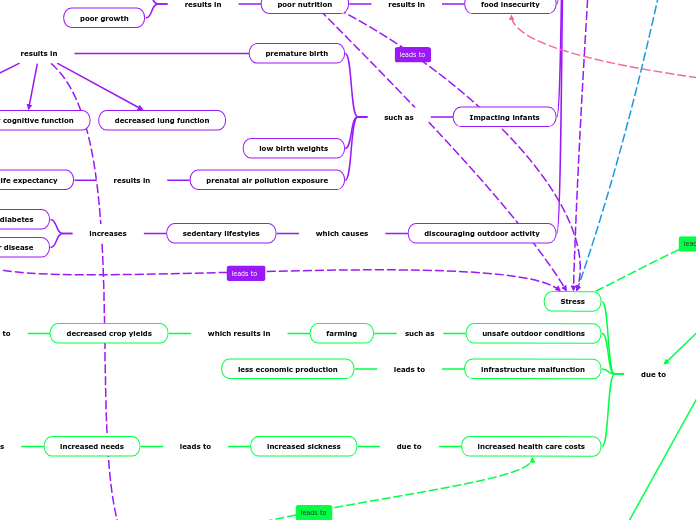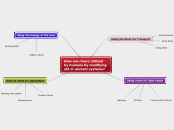Biodiversity Loss
Hamilton, On can reduce the impact of increasing heat on the community's health through sustainable solutions
Urban Heat Island Effect
Cities Absorb Heat
increases A/C use
CO2 emissions
energy use
urban sprawl
pushes urban boundaries
breaches wild life habitat
increased pandemics
more buildings
decreasing green space
highways
massive streets
parking lots
industry
heat by products
vehicles
increase air pollution
give off heat
design
heat absorbing materials
releases absorbed heat
nighttime temperatures
prevents nightly cooling
daytime temperatures
dark sidings
dark shingles
concrete
asphalt
poor air flow
Poor Human Health
discouraging outdoor activity
which causes
cardiovascular disease
risk of diabetes
Impacting infants
prenatal air pollution exposure
decreased life expectancy
low birth weights
premature birth
decreased lung function
lower cognitive function
less development
poor growth
more illness
Mental Illness
low productivity
depression
anxiety
Heat Related Illness
symptoms
cool skin
seizures
confusion
vomiting
pale skin
irregular heart rate
varying severity
Heat Stroke
organ failure
80% fatality
Heat Exhaustion
Heat Cramps
Increased Disease
Increased Antibiotic Resistance
endemics/pandemics
fewer treatment models
more communicable diesase
more sickness
Noncommunicable diseases
liver disease
heart disease
Zootic Diseases
Mosquitos
west nile disease
dengae
yellow fever
Zika virus
Ticks
Lyme Disease
Poor Air Quality
illness
kidney disease
lung conditions
cardiovascular conditions
narrowing arteries
allergies
asthma
because of
More Air Pollutants
Increasing Pollen
Biodiversity Lost
occurs on
Water
results
decreased fish populations
increased pathogens
acidification
leads to
Warming Water
which can
cook organisms
stress organisms
susceptibility to disease
premature deaths
lower reproduction
Land
small fish harvests
poor nutrition
less livestock
Changing Weather Patterns
Precipitation
leads to more
Thunderstorms
Floods
Dryness
droughts
Increased Forest Fires
property damage
Injuries
kills wildlife
Releases Smoke
lowers air quality
poor plant growth
Changing Habitable Zones
Warming Temperatures
habitats become
not too cold
migration northward
invasive species
spread of disease
expand habitat
too hot
population decline
Decreased pollinators
extinction
finding new habitat
cause of increased heat
Climate Change
increases
heatwaves
types
Extreme
impacts
infrastructure
expanding materials
changing air pressures
overheating
melting materials
decreased industrial activity
processing
assembly
manufacturing
refrigeration failures
food transport chains
trains
trucks
causes
spoiled frozen goods
car breakdowns
telecommunication failures
Internet
SMS
less energy production
flight cancellations
bridge failure
train delays
blackouts
everyone
limits activities
being outside
travelling
communication
working in warm workplaces
outdoor activities
working outside
Severe
limiting risk
moderate risk
impacts
outdoor workers
people with chronic medical conditions
young children
elderly
Low Severity
mild risk
very common
becomes
more severe
results in
increased humidity
hotter days
hotter nights
more frequent
in summer
more hot days
fewers cool days
caused by
Increased CO2
Natural Gas Burning
Heavy Industry
Cars
Sustainable Solutions
decrease
impact of heatwaves
heatwaves frequency
During Heatwaves
checking on others
deaths
avoiding physical activity
staying cool
city cooling centers
open to all
public
drinking water
staying indoors
Policy Changes
that encourage
community
which leads to
individual change
socialization
provides
inter-personal support
local investments
cooperation
less air pollution
such as
public awareness
about
benefits of active transport
dangers of air pollution
promoting
active transit
by increasing
shade
planting more trees
safety
community watch
lighting
footpaths
public transit
by improving
reliability
routes
intercity transport
intracity transport
Better Urban Design
using air corridors
improve air flow
decrease air pollution
using white paint
reduces Urban Heat Island Effect
by
increases light reflection
Green Spaces
with ammenities
encourages
outdoor physical activity
rain shelters
water fountains
bathrooms
Trees
Cooling Effect
decreases heat absorption
Decrease CO2
Green Rooftops
decreases heat absportion
which
decreases A/C usage
cools entire building
Community centers
encourage
indoor physical activity
prevents
sedentary lifestyles
improves
happiness
quality of life
physical health
energy efficiency
fossil fuel burning
green energy
which decreases
CO2 Emissions
geothermal energy
Wind Energy
Solar Energy
heat causes
Financial Loss
Job loss
poverty
unhealthy coping mechanisms
overeating
tobacco
alcohol
gambling
drugs
shame
isolation
stress
poor health
increased risk
poor mental health
chronic illnesses
sickness
material deprivation
through
poor performance
due to
increased health care costs
increased sickness
increased needs
days off
acute medical care
hospice
medication
infrastructure malfunction
less economic production
unsafe outdoor conditions
such as
farming
which results in
decreased crop yields
leads to
food insecurity
Stress









